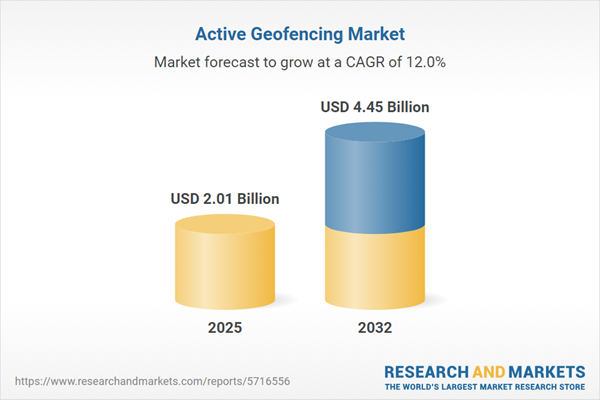Speak directly to the analyst to clarify any post sales queries you may have.
The active geofencing market is transforming how organizations manage security, compliance, and operational resources. As businesses confront regulatory and operational shifts, active geofencing enables more adaptive, resilient, and efficient strategies supported by data-driven insights and evolving technology.
Market Snapshot: Active Geofencing Market Overview
The global active geofencing market is in a period of significant growth, posting a compound annual growth rate of 12.02%. Market value is projected to climb from USD 1.79 billion in 2024 to USD 2.01 billion by 2025, with expectations to reach USD 4.45 billion by 2032. This growth is propelled by accelerated digital transformation across sectors like retail, transportation, and public services. Senior decision-makers view active geofencing as a fundamental solution for driving operational efficiency, ensuring regulatory conformity, and maintaining agility in competitive international contexts.
Scope & Segmentation of the Active Geofencing Market
- End User: Financial institutions, healthcare providers, retailers, logistics firms, emergency services, and government agencies use active geofencing to secure assets, monitor workforces, and optimize supply chains. Its adoption spans environments where continuous oversight and rapid response are priorities.
- Component: Most offerings integrate hardware, scalable software, and support services. This modular integration lets organizations tailor deployments as operational needs shift, balancing initial investment and ongoing support.
- Type: Dynamic active geofencing supports management of mobile assets or distributed teams, while static configurations deliver oversight for fixed facilities or grouped assets, enabling precise security and access controls.
- Location Type: Indoor solutions enhance safety and workflow efficiency in hospitals, warehouses, and campuses. Outdoor implementations facilitate remote asset and fleet monitoring across wider territories or supply chains, supporting robust operational continuity.
- Deployment Mode: Cloud-based deployments offer streamlined scaling and updates, ideal for organizations seeking rapid implementation. On-premise alternatives support heightened security, compliance, and local policy adherence in sensitive data settings.
- Application: Use cases range from asset tracking, incident response automation, and workforce analytics to behavior monitoring and compliance with regulatory and safety policies.
- Organization Size: Scalable frameworks address the unique requirements of both large enterprises and small businesses, supporting customized feature sets and budget allocations.
- Pricing Model: Subscription and pay-per-use models allow clients to align expenses with changing project scopes and flexible IT planning.
- Regional Coverage: Strong adoption is observed in the United States, Germany, China, India, Canada, and Australia. Providers customize solutions to fit distinct regulatory, infrastructure, and operational demands in these and other regions.
- Key Companies: Leading firms such as Google LLC, Oracle Corporation, HERE Global B.V., Foursquare Labs, GroundTruth Holdings, Near Pte. Ltd., Radar Labs, PlaceIQ, Unacast AS, and Cuebiq, Inc. shape the evolution of active geofencing through ongoing standards innovation and real-world application enhancements.
Key Takeaways for Senior Decision-Makers
- Artificial intelligence and edge computing integration magnify automation capabilities, providing timely operational insights while strengthening risk mitigation for fast-changing environments.
- Advanced location intelligence enhances resource allocation and establishes end-to-end oversight of assets, personnel, and high-value workflows, reducing lost productivity and error risk.
- Robust adherence to evolving data privacy standards sustains regulatory compliance and secures information integrity within increasingly complex digital and physical networks.
- Cloud-native solutions enable agile responses to shifts in operational, compliance, or market requirements while simplifying the digital transformation process.
- Partnerships with IT and telecom vendors facilitate smooth implementation and support alignment with specific sector and regional mandates.
- Adaptable procurement and financial models make it easier for organizations to synchronize investment in geofencing technologies with planning cycles and resource needs.
Tariff Impact and Supply Chain Considerations
Frequent global tariff changes are increasing hardware expenses, prompting vendors to diversify sourcing strategies and strengthen supply chain resilience. This trend is accelerating the shift to software-centric and cloud-based geofencing solutions, helping organizations maintain regulatory compliance and operational continuity even as international trade dynamics evolve.
Methodology & Data Sources
This assessment synthesizes quantitative metrics, practitioner input, technical analysis, and regulatory review. Multiple authoritative references confirm findings, delivering relevant and defensible insights for leadership decisions.
Why This Report Matters for Strategic Decision-Makers
- Delivers targeted market intelligence to inform technology adoption, operational streamlining, and best-practice geofencing deployment.
- Supports secure and adaptable operational models by providing current market analysis and tailored supply chain recommendations.
- Guides organizations through digital transformation benchmarks for resilient, location-driven enterprise processes and decision-making.
Conclusion
Active geofencing empowers organizations to strengthen security, optimize resource management, and adapt efficiently to changing regulatory and market conditions. Effective deployment supports proactive risk mitigation and long-term operational excellence.
Additional Product Information:
- Purchase of this report includes 1 year online access with quarterly updates.
- This report can be updated on request. Please contact our Customer Experience team using the Ask a Question widget on our website.
Table of Contents
3. Executive Summary
4. Market Overview
7. Cumulative Impact of Artificial Intelligence 2025
Companies Mentioned
The companies profiled in this Active Geofencing market report include:- Google LLC
- Oracle Corporation
- HERE Global B.V.
- Foursquare Labs, Inc.
- GroundTruth Holdings, LLC
- Near Pte. Ltd.
- Radar Labs, Inc.
- PlaceIQ, Inc.
- Unacast AS
- Cuebiq, Inc.
Table Information
| Report Attribute | Details |
|---|---|
| No. of Pages | 190 |
| Published | October 2025 |
| Forecast Period | 2025 - 2032 |
| Estimated Market Value ( USD | $ 2.01 Billion |
| Forecasted Market Value ( USD | $ 4.45 Billion |
| Compound Annual Growth Rate | 12.0% |
| Regions Covered | Global |
| No. of Companies Mentioned | 11 |









